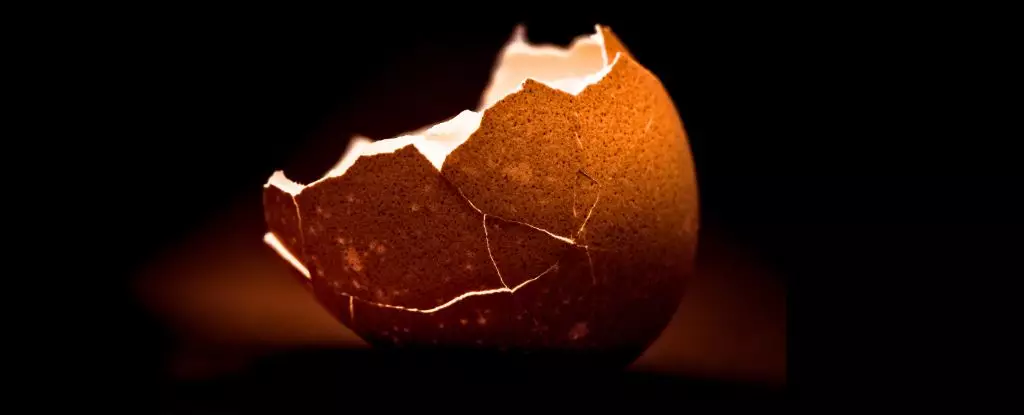Peeling a boiled egg can feel more like a high-stakes challenge than a culinary task. How many of us have faced the disappointment of a beautifully cooked hard-boiled egg, only to be met with a mangled mess of fragile shell and mushy white? The egg, once a picture of potential for a delightful snack or a perfect addition to a salad, now resembles a battlefield. This everyday kitchen struggle is endured by many, prompting a slew of “hacks” that surface on social media, each claiming to unveil the secret to easy peeling. However, the science behind the peeling process is more complex than a simple trick or tip.
The Anatomy of an Egg: Understanding What Makes Peeling Difficult
To grasp why peeling can be such a challenge, it’s essential to understand the composition of an egg. Eggs consist of a fragile outer shell, an inner and outer membrane, the egg white (albumen), and the yolk nestled at the core. Between the inner and outer membranes lies an air cell that grows as an egg ages—this is critical to the peeling process. Research conducted in the 1960s and 1970s highlighted that the age of the egg significantly affects how it can be peeled. Fresh eggs, while ideal for many recipes, are notorious for the misery they bring when it’s time to crack their shells.
The Science of pH: A Key Factor
One of the most surprising factors influencing the ease of peeling is the pH level of the egg white. It has been established that egg whites need to be in an alkaline range, around 8.7 to 8.9, for optimal peeling. Fresh egg whites typically start in a more acidic state, thus making them stickier against the membranes. As eggs age, this pH gradually rises, facilitating an easier separation from their shells. Hence, using older eggs is one of the simplest secrets for achieving the perfect peel—opening up a Pandora’s box of possibilities for home cooks who have previously only used the freshest eggs.
Temperature Tricks: The Ideal Storage Conditions
In addition to pH, the storage temperature of eggs plays a pivotal role in peelability. Research indicates that eggs stored at approximately 22 degrees Celsius (72 degrees Fahrenheit) peel more readily than those kept at lower temperatures—such as in the refrigerator. This observation presents a conundrum; while cooler temperatures are generally synonymous with longer shelf life and safety from spoilage, they also contribute to the eggs’ stubbornness during peeling. Careful planning and balancing of temperature can make a significant difference in your kitchen experience.
Boiling Techniques: Getting it Just Right
Once you’ve selected your eggs based on freshness and storage conditions, the cooking method itself is essential. Many culinary aficionados suggest starting the boiling process with just the right technique: using boiling water and then lowering it to a simmer before gently adding room temperature eggs. This method is thought to help the membrane release from the egg white more easily, a common frustration for many. Additionally, quick heat exposure can hasten the denaturation of proteins in egg whites, promoting a smoother peel.
Cooling Down: The Ice Bath Method
Once your eggs have been boiled to your desired level of doneness—whether soft, medium, or fully hard-boiled—a brief plunge into ice water can work wonders. The cold shock causes the egg white to contract slightly, further aiding detachability from the shell. This technique is simple yet incredibly effective, emphasizing the importance of not just the cooking phase but the immediate aftermath as well.
Beyond Boiling: Exploring Alternative Cooking Methods
If traditional boiling isn’t yielding the desired results, consider experimenting with alternative cooking methods. Steaming eggs has gained traction in recent years, as proponents suggest that steam’s ability to penetrate the eggshell could ease peeling by loosening the membrane. Additionally, the newer techniques of air frying and even microwave cooking present newfound avenues of exploration for egg enthusiasts eager for perfection.
Eggshells: Not Just Kitchen Waste
After overcoming the peeling hurdle, don’t discard the shells thoughtlessly. Eggshells have myriad practical applications, ranging from enriching garden soil to acting as a natural pest deterrent. Their residual calcium carbonate content can be a valuable resource beyond the cooking process, allowing environmentally conscious cooks to make the most of every ingredient.
Achieving perfectly peeled boiled eggs takes a combination of knowledge, technique, and a little science. By understanding the properties of the egg and how various factors influence the peeling process, anyone can elevate their egg game. So, the next time you tackle a batch of boiled eggs, remember these insights, and enjoy a flawless peeling experience.

